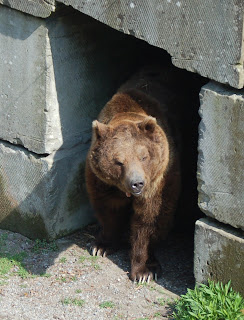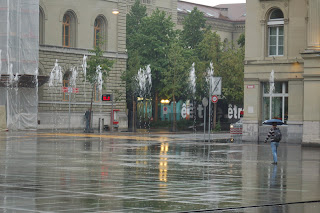Up with the dawn. This would become a theme. We were also up with the rainclouds. The steady drizzle accompanied us to the Munich underground and wouldn't really stop until after dinner that evening. There’s nothing like a sunny June in Europe.
With our rail passes bearing a sufficient number of German stamps we climbed aboard our first long distance train of the trip. Riding southwest across the country, Tim and Michael discovered the beautiful relaxation of the rails. We wrote in our journals, snacked, chatted, and snoozed.
Unfortunately they also learned a few of the stressors of the rails as we caught connections that zigzagged over the border. Our passes only covered Germany, Switzerland, and Benelux (a contraction of Belgium, The Netherlands, and Luxembourg) so we had to avoid dipping into the Austrian pan-handle, making for a lot of up, down, and transfers (though we did get a passing glimpse of the Rhine Falls, the Niagara Falls of the German World thanks to our goofy path). The whole time we prayed for sunny skies. They were not heard.
Luzern is the capital of the canton of Luzern (go figure) and is a touristic hub of the country because it sits right in the center of the Switzerland. Theoretically the town is overshadowed by the imposing Mt. Pilatus, but the cloud banks and drizzle prevented us from getting much of a view. Instead, we had plenty of time to size up the man-made attractions of the city.
The city rests on the banks of the Reuss River which dumps into Lake Luzern. There was a lot of river traffic in the area and a lot of people wanted the city for their own, so the citizens built the Wasserturm (Water Tower) and Kapellbrücke (Chapel Bridge) over the river to help defend the town. Now, lined with flower boxes and decorated with images of Luzern’s past, the combo of the bridge and tower make an iconic image.

The bridge (superlative alert) is the oldest wooden bridge in Europe, but in 1993 a fire nearly burned the whole structure to the level of the river. It was quickly rebuilt and new sprinklers installed to prevent the icon from going up ever again.
On the other side of the bridge we followed the recommendations of several guidebooks to a microbrewery on the banks of the river. Despite grey skies and overpriced pretzel sandwiches (but what isn’t overpriced in Switzerland) we enjoyed the experience of sipping cold beer under a stone balcony with a view of the medieval bridge and Baroque churches (if not mountains).
We crossed back over the river and popped into the Jesuitenkirche (Jesuit Church) so we could check out the ornate, Rococo interior and dry out a bit. The church was dedicated to St Francis Xavier, one of the great badass missionaries of the early Jesuits (and patron of my high school). He ventured across Asia, particularly focusing on Japan, Indonesia, and India. His dream was to proselytize in China, but he died on a Chinese island, waiting for a ship to the mainland.

The church was dedicated by the Pope in 1574 as a bastion against the rising Protestantism of Switzerland. In 1666 it was dedicated to Xavier. The ceiling of the interior is decorated with images from Xavier’s life and travels including his ride to heaven in a chariot pulled by an elephant, a camel, and a leopard as symbols of his missions. Somehow I don’t think such a chariot would get very far, but I guess when you’re on your way to heaven the animals can learn to play nice. The rest of the interor showcased the pyrotechnics of the counter-reformation where ornate marble (it’s fake) and gold leaf (real) were meant to inspire awe in all who entered.

Out into the weather and over another wooden bridge. This one has mill wheels attached to the base and the paintings feature the Dance of Death. Nuns, farmers, mayors, brides, and merchants are dogged by the leering skeletal face of Death. Cheery imagery for our tour of Luzern.

We started to wander through the shopping district, but changed our course when we saw signs for the city walls and defense towers. We weren’t in Amsterdam yet, but we wanted to get high. Up the steeply sloping streets, and up a narrow flight of stairs. We had an impressive view of the city and lake, obstructed only by wide chicken wire. When smoking was made illegal in town a couple centuries ago, the soldiers would hide in the towers to get their nicotine fix.

Today tourists heave themselves up the ladder-like stairs to leave graffiti mementos then contemplate the treacherous walk back down.

From the old wall we had to figure out the most efficient route to Luzern’s most popular attraction: the Lion of Luzern.
The monument is carved directly into the rock and shows a dying lion with a spear point sticking out of his side, tears on his anguished face, and his head resting on a French shield. Just because the Swiss don’t get involved in wars as a nation, doesn’t mean their citizens don’t like to fight. Swiss mercenaries were the best soldiers money could buy. They were the guards of Europe’s emperors, kings, and pope. In 1792, a mob of French Revolutionaries charged the royal palace in Paris, massacring hundreds of mercenaries who ran low on ammunition and just couldn’t deal with the massive hoards. After surrendering the palace, hundreds died in prison or were slaughtered during the September Massacres when the mobs of Paris killed half the prison population of the city. Not a great moment in history, so the lion is understandably tragic.

Michael reflected that it was hard to see the memorial as completely noble. These were mercenaries. They sold their loyalty and died defending a foreign king against his citizens for no reason beyond the cash in their pockets. I don’t know if that’s completely fair. The Swiss Guard had been employed in France since the 16th century. Many of the soldiers were arguably more French then Swiss by the 18th. They were fighting for their king just as the Vatican’s Swiss Guard takes their loyalty to the Pope as seriously as the Secret Service takes their defense of the U.S. President.

With the rain steadily falling we had a quiet moment to spend with the dying lion before retreating to the Hofkirche. Again, the façade was impressive, but we just needed a place to dry for a bit. As the main church of the city it was once the home of the Papal Nuncio. Now it’s decorated with all the filigree and wrought iron that you might expect in an important church with a more reserved Swiss attitude towards decoration.

Back to the station and a short ride to Bern, the capital of Switzerland. I visited on a much sunnier day back in April so I was able to confidently lead us to our first hostel, the clean and quiet Hotel Glocke. We dropped our bags, shook off the wet, then went into the streets for a brief walk around the Old Town and a hunt for food. My first destination was the bear pits. The bears are the symbol of the city (Bern=bear) and a pit stop is essential. We crossed the soaring stone bridge over the Aar River and were confronted with this sign:

It reads “Pedro is dead.” The old bear who was donated by the city of Barcelona (thus the Iberian name) died April 30th after his arthritis, which they had been treating for two years, became unbearable (pun un-intended). Poor Pedro.

Back over the bridge and past the Münster (Cathedral) that was gutted by zealous iconoclasts during the Swiss Reformation...

and on to the Parliament building where the fountain ignored the fact it was raining. Kids with umbrellas and too much time dodged through the water, gasping in shock when the erupting jets caught the inside of the umbrella and drenched them.

Near parliament was a street festival that required some kind of cover charge. As we walked by we could hear a classic rock cover band blasting from the stage with only two people on the ground watching. A tragic image, but we couldn’t beef the numbers. We needed food and an early night so we could get up at the crack of dawn to climb a mountain the next morning. We walked by an Italian place and sized up the menu. The Swiss prices pushed us on. Slowly we realized we would find nothing cheaper or drier so we sheepishly went back to the restaurant and were lead to a seat in the middle of the dining room.
We ordered pizza (always the cheapest option) and Tim and Michael learned the muscular art of eating a crisp pizza crust with a fork and knife. By the end Michael was complaining of tennis elbow from all the sawing. When it was time to pay we looked for our Italian? Russian? waiter who had seemed overwhelmed by our bad pronunciation and drink orders (is “Bier, bitte” really that hard to sort out?). He was nowhere to be found. Ah, there he is, “Enschul…” Nothing. Every time he swept by, we fought for his attention. We sat and waved for the better part of a half-hour. We started pooling our pennies (or Franks) to just leave on the table in frustration when if finally dragged himself to our table to collect our patronage. I’ll admit that I’m looking forward to attentive service on the other side of the pond.
Finally we were free to go, gawk at a fountain I had somehow missed in April that features a giant devouring naked children, and call it a night. We needed our rest. We had a mountain waiting for us.

I hope your barbecues, block parties, and fireworks were a literal blast, and stay tuned for the continuing adventures of the Blazing Buckeyes!
Tschuss!
The pictures.

No comments:
Post a Comment